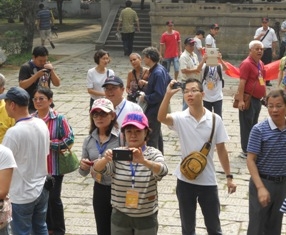Travel and Tourism in a fast-changing world : new trends

Euromonitor International released the 2013 World Travel Market Global Trends Report at World Travel Market (WTM), the leading event for travel and tourism globally. The report, produced for the eighth year running by Euromonitor, presents the nine key emerging travel and tourism trends in the world, looking at how the industry is developing in a rapidly changing global economic and social environment.
The report identifies the key tourism trends set to shape the travel and tourism industry in seven regions and two core strategies:
Americas PANKS – A New Demographic
UK Travel Happiness Index
Europe Next Generation Peer-to-Peer Travel
Middle East Low-Cost Goes Upmarket
Africa The Big Five with Your Little One
Asia Fight for Cruise Control in China
India The Travel Social Shake-Up
Travel Technology Mobile Concierge
Global Village Vacancy on Demand – Chasing the 24-hour Traveller
Americas: PANKS – A new Demographic
The US travel industry is targeting PANKs – ‘Professional Aunt, No Kids’ – who collectively spend billions on travelling with nieces and nephews. As of 2010, just over 42% of women in the US aged 15 to 44 were childless, as women have children later in life or choose not to have children at all. Travel firms aware of the power of PANKs’ spending can tap into this lucrative, expanding market.
UK: Travel Happiness Index
Brits are leading the way in Europe to find happiness above the clouds, or at least on board their flights. US-based flight meta-search website, Routehappy.com, is leading this quest for contentment. Launched in April 2013, it provides a unique measurement of customer satisfaction via its ‘happiness scores’ for airlines, helping consumers select flights based on comfort and suitability. With more than 100,000 unique visitors at launch and over 30% of visitors returning in July 2013, the site is a unique offering with the UK as its leading European source of demand. Airlines are working hard to move away from air travel being a commoditised, price and schedule-only decision. It is to be seen if other transportation modes, as well as hotels and travel retail players, will follow this model in future.
Europe: Next Generation Peer-to-Peer Travel
Europe continues to struggle with low GDP growth. As Europeans seek cheaper travel options to counteract continued austerity, the sharing economy offers opportunities at lower prices than ever before. The range of accommodation is very diverse, thanks to the growth of brands such as Airbnb, HouseTrip and HomeAway. TripAdvisor has embraced the concept by acquiring Flipkey, as well as listing HouseTrip and Airbnb as trusted partners for rentals. Tours, guiding and unique travel experiences are offered by sites such as Touristlink and Vayable. Car sharing services are also growing in Europe, where Avis bought car-sharing company Zipcar for US$500 million in 2013, while Blablacar.com had more than three million members in 10 European countries. The future of peer-to-peer holiday rentals depends on legislation, but is proving successful and is expected to grow.
Middle East: Low-Cost Goes Upmarket
Middle East travellers with a taste for the high life are seeing a few more frills on their budget airlines. Consumers in the region have a penchant for luxury. However, a surprising twist is the introduction of luxury services aboard low-cost carriers. Jazeera Airways was the first to introduce a business class in 2009, whilst keeping lower prices and achieving profitability. In 2013, Flydubai is following suit with its new business class services. Will this hybrid model expand to low cost airlines in other regions? The Flydubai experience will show us how sustainable the model really is.
Africa: The Big Five with Your Little One
Child-friendly safaris in Africa are becoming more popular, as more grandparents and children join in with family holidays. Hollywood hits such as Madagascar and the Lion King mean that kids around the world now want to see the ‘big five’ for real. Previously, safaris have been considered unsuitable for youngsters but safaris in Africa now avoid long game drives – which suits kids’ shorter attention spans. Multi-generational holidays in Africa could expand beyond safaris to volunteerism and more sustainable holidays, as well as cruises.
Asia: Fight for Cruise Control in China
It’s full steam ahead for the Chinese cruise market, which is on course to become the second largest global cruise market after the US by 2017. Cruising in China is still in its infancy, yet it is registering buoyant growth. Royal Caribbean said its Chinese passengers quadrupled from 25,000 to 100,000 between 2011 and 2012, with numbers predicted to reach 200,000 in 2013. The Chinese government has also spotted cruising’s potential and declared 2013 as Marine Tourism Year, with the latest five-year plan dictating that cruising is an industry with exciting growth potential.
India: the Travel Social Shake-Up
Only 12% of the Indian population is online yet Facebook claims to have 82 million users in the country, making India its third largest global market after the US and Brazil. India’s online travel agencies are prioritising social media to woo young urban consumers. The Indian Ministry of Tourism has recently started using social media to promote tourism sites throughout the country, and 70% of all four- and five-star hotels in the main cities have established their social media presence.
Travel Technology: Mobile Concierge
By its very nature, travel is a mobile activity – so the travel trade is using mobile devices as a sales and customer service channel and have developed mobile concierge services. Travellers now expect real-time answers and greater customisation, wherever they are and at any time, before, during and after the trip. Online travel sales recorded another strong performance in 2012 growing by 8.4% globally to reach US$524 billion. World online travel sales growth is expected to continue steady in the next five years at a 9.5% CAGR.
Global Village: Vacancy on Demand – Chasing the 24-hour Traveller
Hotels are increasingly renting rooms to business and leisure guests for ‘microstays’ during the day. More business guests are seeking day-use rooms for various reasons, including a chance to relax between appointments or flights, or workspaces for meetings at the hotels. Hotels will become ‘offices of the future’, and this is very much likely to become a global trend.
( Euromonitor International is the world’s leading provider for global business intelligence and strategic market analysis with more than 40 years of experience publishing international market reports, business reference books and online databases on consumer markets.)
Nov.5 , 2013














